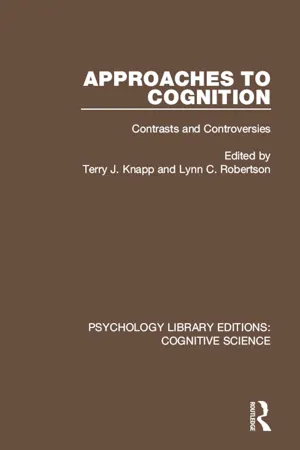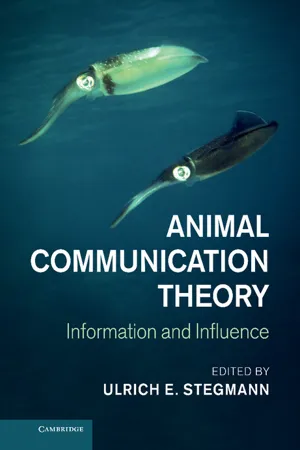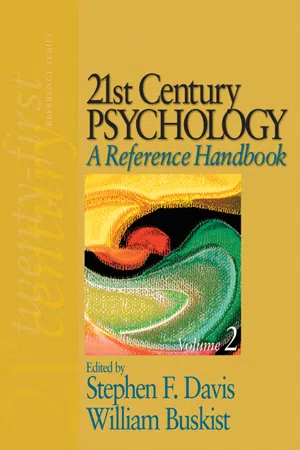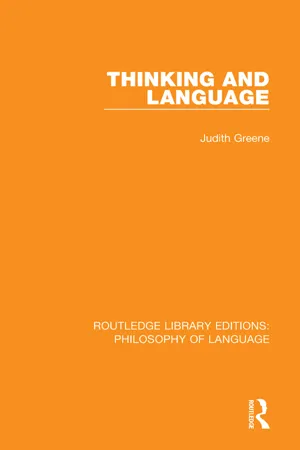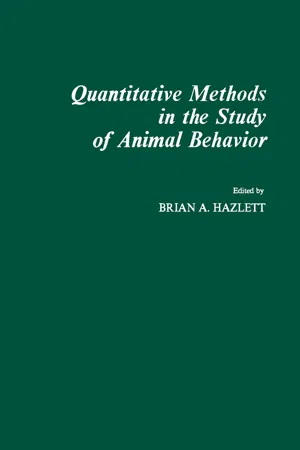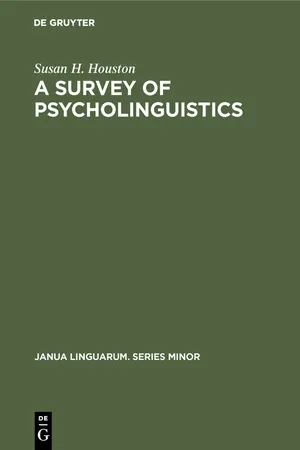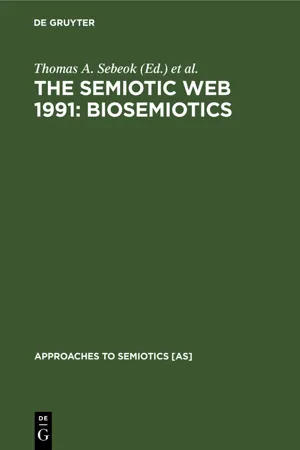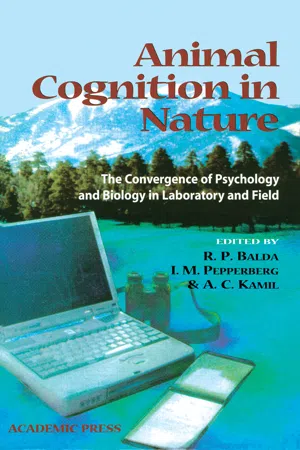Psychology
Animal Thinking and Language
"Animal Thinking and Language" refers to the cognitive processes and communication systems of non-human animals. It explores the extent to which animals can think, problem-solve, and communicate using language or other forms of symbolic communication. Researchers study animal cognition and language abilities to gain insights into the evolution of human cognition and language, as well as to better understand the capabilities of other species.
Written by Perlego with AI-assistance
Related key terms
1 of 5
12 Key excerpts on "Animal Thinking and Language"
- eBook - ePub
Approaches to Cognition
Contrasts and Controversies
- Terry J. Knapp, Lynn C. Robertson(Authors)
- 2016(Publication Date)
- Routledge(Publisher)
Finally, only a comparative analysis will inform us of the evolutionary history of cognitive processes. Although this is not now a central issue in cognition, it is clear that knowledge of which types of processes are primitive, which are recent developments, and which are unique specializations will make our understanding of animal cognition more complete. Gathering such knowledge is a complex task, but methods have been developed to discover the evolutionary history of certain behaviors (e.g., Greene, 1978). Similar methodology could conceivably be applied to the study of the evolution of cognitive processes. An example of this general approach is the study of animal communication to better understand the evolution of human language (cf. Parker & Gibson, 1979). In attempting to analyze the similarities and differences between nonhuman and human communication systems, the definition and necessary attributes of language have become more precise. Eventually, this analysis may reveal which attributes of human language are relatively primitive (i.e., are shared with the common ancestor of humans and whichever species also exhibit this attribute) and which attributes are unique specializations of our species.SUMMARYWe have examined the history of ideas about animal cognition, illustrated their current state, and suggested some potential roles that the field might have in the future of psychology. We have also addressed the criticisms that have been made of the cognitive enterprise. The modern study of animal cognition has shifted from an interest in the explanation of molar behavior that characterized it earlier in this century to the use of behavioral tests to evaluate hypotheses about the nature of internal processes. In this respect, the modern enterprise is borrowing methods and concepts from the field of human information processing (cf. Blackman, 1983; Riley & Leith, 1976). It is clear that the cognitive processes that have been inferred are meant as descriptions of causal factors that are properties of the functional organization of the nervous system. These hypothesized mechanisms have predictive power in situations where historical analyses have difficulty predicting behavior. Finally, we have described how the study of cognitive processes is enriched by consideration of their function and argued for a more ecological approach to the study of cognition. - eBook - ePub
Unsolved Mysteries of The Mind
Tutorial Essays In Cognition
- Vicki Bruce(Author)
- 2021(Publication Date)
- Psychology Press(Publisher)
The surest way to demonstrate that animal communication works like human language would be to find a way in which both animals and humans could translate between the two. It would be easy, therefore, for this chapter to resolve into a discussion of whether animals can learn a language that is more obviously like the human version. As is well known, this question has been taken up in a series of experimental projects with chimpanzees, using human sign languages (initiated by Gardner & Gardner, 1971), or artificial languages constructed out of symbols, either plastic (as in the project initiated by Premack, 1976), or displayed by a specialised computer keyboard and display (an approach which began with Rumbaugh, 1977). These techniques, which have since been extended to other great apes, have opened up the question of animal language learning to experimental analysis. But in some ways they lead us away from the main question we are posing in this chapter. We are not asking whether animals can learn to think by means of learning a human language through human intervention. We are asking whether animals under normal conditions, without such a language, are able to think.But even if we accepted that animal communication has nothing in common with human language, and that animals cannot learn any form of human language, would that imply that they have no mental processes at all? Does the absence of language imply the absence of either consciousness or thought? We accept of course that human thought and human consciousness are closely intertwined with human language. Already in this chapter we have argued that we know that humans can think because they claim to think—and the claim is made linguistically But it does not follow that thought without language is impossible, either for humans who do have language, or for animals, who do not. Our argument is that this should be an empirical, not an a priori question, still less one to be settled by definitional fiat; and the question of animal thought is part of the evidence that should be brought to bear on it. Moreover, there are at least two a priori arguments against making language the criterion for the existence of cognition. First, if we take such a position, we have to argue that babies and seriously intellectually disabled people have no minds (just as Singer, 1976, argues that we would have to deny any moral responsibility to them), a position most people would reject as inhuman. Second, we have to invent a category of non-cognitive or mindless learning, because no-one could argue that animals do not learn. That is, of course, precisely what is connoted by the term “conditioning” as it has been used in psychology, particularly behavioural psychology; and it is significant that there is growing evidence that even the kinds of learning involved in conditioning experiments cannot be explained without reference to cognitive processes (see, for example, Dickinson, 1980). - eBook - PDF
Animal Communication Theory
Information and Influence
- Ulrich E. Stegmann(Author)
- 2013(Publication Date)
- Cambridge University Press(Publisher)
Indeed, mental processes were subsequently cast as a kind of language of thought (Fodor, 1975). 6.3 Cognitive ethology and the rethinking of animal communication The promise of Chomskyan linguistics and digital computing for under- standing the architecture of mental processing and complex behaviour was not lost on scientists of animal behaviour. Historically, issues concerning animal mental life had been central to comparative psychology, and after decades of the strictures of behaviourism, researchers were ready to embrace this prohibited topic once again. Just as language was seen to reveal the workings of human minds, communication systems in animals were seen as privileged windows on their minds (Griffin, 1974, 1995). Indeed, animals were proposed to demonstrate complex cognition in proportion to the degree to which their communication showed evidence of language-like properties. Language thus quickly emerged as a core metaphor for understanding animal communication, and was readily connected to the information-processing metaphors emerging in the study of cognition (Marler, 1961). The two emphases came together in the new field of cognitive ethology, a synthesis of animal behaviour and psychology. The new approach took a large leap forward through seminal work on primate vocal communication by Seyfarth, Cheney and Marler. That work showed that vervet monkeys give acoustically distinct alarm calls to different predator types and that the calls alone elicit different escape responses (Seyfarth, Cheney & Marler, 1980a). Hence, the calls appeared to function as symbolic labels for the predators, much like human words. Because these sounds showed no iconic resemblance to the predators, they also seemed to exemplify the arbitrariness that de Saussure proposed for language. Here, then, was evidence of language- like communication in a monkey, with the promise of similarly human-like cognitive complexity. - eBook - ePub
- Graham C. Davey(Author)
- 2018(Publication Date)
- Wiley(Publisher)
So, what does the riddle tell us about language and thinking? A broad conclusion, but one that is only partly misleading, is that language is easy and thinking is hard. When we speak or read a language that we have learned in childhood, it comes naturally to us. Thinking, on the other hand, is often difficult. As the surgeon riddle shows, it can be compromised by preconceptions. And, when we engage in conscious trains of thought, we often experience the cognitive effort of thinking about complex matters in a way that we don’t experience when using language.In this chapter, we will look at language and thinking separately, as there are different traditions in cognitive psychology, which is the discipline in which language and thinking are studied. At the end, we will ask how they are related, since thoughts are often expressed in language and, at least for many people, language is the main medium for thinking.SECTION SUMMARY
- Language and thinking pervade human life.
- Language is easy to use; thinking can be hard.
- Language and thinking are usually studied separately in psychology – a division followed in this chapter.
LANGUAGE
LEARNING OBJECTIVE 12.2
Describe the evolution and structure of language as a communication tool, how language is acquired by children and used by adults (including bilingual adults), and the role of the brain in language use.
LanguageHuman and animal communication - Stephen F. Davis, William Buskist, Stephen F. Davis, William F. Buskist(Authors)
- 2007(Publication Date)
- SAGE Publications, Inc(Publisher)
285 31 A NIMAL C OGNITION B RADLEY R. S TURZ Armstrong Atlantic State University K ENT B ODILY , M ICHELLE H ERNÁNDEZ , K ELLY S CHMIDTKE , AND J EFFREY S. K ATZ Auburn University A nimal cognition refers to the mechanisms by which nonhuman animals process information and is primarily concerned with understanding how animals learn, store, remember, and respond to information from the environment. Although similar in many respects to the present-day fields of animal learning, behavioral ecology, and ethology, animal cognition has emerged as a distinct area of study by adopting the infor-mation-processing perspective from human cognitive psy-chology. The information-processing perspective assumes that animals form and manipulate internal representations about their environment. As such processes afford flexibil-ity and adaptability in behavior necessary for survival in an ever-changing environment, the information-processing perspective has proved useful in explaining and predicting numerous behavioral phenomena in animals. Historically, animal cognition finds its roots in the American tradition of animal learning (e.g., Edward Lee Thorndike) and the European tradition of ethology (e.g., Konrad Lorenz, Niko Tinbergen). Each tradition differs in approach and method of investigation. Whereas etholo-gists often stress adaptive specializations and focus their studies in the context of an animal’s natural environment, those studying animal learning often stress general pro-cesses and focus their studies in the context of a labora-tory. Despite the rich historical roots in these traditions, animal cognition did not emerge as a distinct field of study until shortly after the cognitive revolution of the 1960s. It was then that the information-processing perspective was infused into the fields of animal learning and ethology. Since that time, animal cognition continues to mirror its human counterpart in focus and theory while maintain-ing an interest in learning and behavior.- eBook - ePub
- Judith Greene(Author)
- 2016(Publication Date)
- Routledge(Publisher)
5Thinking and language: some problemsThe aim of this chapter is to bridge the gap between the first part of the book on thinking and the second part on language. It must have become increasingly obvious that to talk about thinking while ignoring language is an extremely lopsided affair. Verbal labels are not only of crucial importance in concept attainment experiments but are the chief medium of all types of thinking. Task instructions are couched in verbal form, hypotheses are expressed verbally and subjects’ talking aloud is considered to give at least some indication of their thought processes. Is it any wonder that the issue of whether language is necessary for thinking has proved an endlessly fascinating topic?The interaction between thought and language has been given its most illuminating analysis by the great Russian psychologist Vygotsky, whose book Thought and Language, first published in 1934, has been translated into English (1962). Vygostky’s view is that language has two distinct functions: external communication with one’s fellow human begins and, equally important, the internal manipulation of one’s inner thoughts. The miracle of human cognition is that both these systems use the same linguistic code and so can be translated – with more or less success – one into the other.That this is by no means necessary can be demonstrated by looking at animals. There is no doubt that animals can ‘think’ in the sense of solving complicted discrimination problems, even succeeding in learning oddity problems by picking out the odd stimulus out of three, a problem which presumably entails some quite complicated ‘inner representation’. Equally, there is no doubt that animals have extensive systems of communication: vocal cries, visual signals, smells, and so on. But what no animal has so far been able to do is to walk out of a psychological experiment and tell the next monkey in line, ‘There’s a mad professor in there who will give you a banana if you choose the odd one out.’ In other words, the monkey is not able to translate whatever processes he uses for internally representing a problem into a form that he can communicate externally. I say so far because of the remarkable recent work on teaching sign languages to chimpanzees which will be briefly described in section 5 - Brian Hazlett(Author)
- 2012(Publication Date)
- Academic Press(Publisher)
Further-more, the specific words used are defined by the ways in which they are used rather than by fixed relations to specific ob-jects which they represent. These ideas can be extended to encompass behavior if we consider the acts of animals the operational equivalent of words. More specifically, if we suppose that behavioral acts admit to classification and groupings when considered from the animal's point of view, then activities constitute linguistic behavior in Wittgenstein's sense. Furthermore, the ultimate meaning of the animal's behavior can be found only by consid-ering its ecological and evolutionary effect in conjunction with more immediate consequences. Since the animal's behavior is conditioned by and responsive to events occurring in its environment, behavior is simply the animal's side of an on-going operational dialogue between the animal and its environ-ment. In this sense social communication is only one of the language-games in which an animal engages. It is to be understood that the term behavior in this ENVIRONMENTAL LANGUAGES 147 context includes not only overt ethological acts but physiolo-gical and developmental events as well. All too often practi-cal restrictions on empirical methods have led to the study of development, physiology and ethology separately and without adequate reference to each other. Nevertheless it is necess-ary to retain the distinctions in part if we are to have any hope of deriving an empirical methodology from the theory pre-sented here. In doing so, however, it must be remembered that the distinctions are provisional and for methodological con-venience only. B. Scope of This Paper I shall argue below that a linguistic approach not only leads to viable experimental methods but permits inclusion of many considerations not encompassed by traditional methods, such as effects of the spatial structure of an animal's en-vironment or the import of variable durations of and time in-tervals between events.- eBook - PDF
- Susan H. Houston(Author)
- 2019(Publication Date)
- De Gruyter Mouton(Publisher)
Although animals do communicate with one another, this com-munication is not generally spoken of as language. Animal com-munications are invariably about concrete and physically present objects or 'about' (that is, because of) biological drives. This is one strong argument for suggesting that they do not constitute genuine linguistic behavior. Too, insofar as is now known, animal communication never is hierarchically organized or sys-temal, nor does it contain etic/emic patterning on any level, so that it cannot be represented as can language by orderly rules 2 8 0 LANGUAGE AND COMMUNICATION: ANIMAL LANGUAGE which map its levels into one another and build its units into utterances. Finally, it is undoubtedly necessary that some utter-ances within a genuine language may be characterized as well-formed, thus implying the existence of another set of utterances which may be labeled as less well-formed or as non-well-formed, so that not every possible sequence of noises is a good or gram-matical utterance within the language. Animal communications are presumably all well-formed, and do not in general contain the possibility of producing non-well-formed utterances (nor do they seem to have redundancy in the same sense as human language). It is in addition currently accepted that no other species (again, with the possible exception of dolphins) has the neurological equipment for language (cf. Lenneberg, 1967, pp. 52 ff.). It does not appear that language is approximated even by higher pri-mates, nor that it developed by accretion of separate traits some of which are evinced by such primates (cf. Lenneberg, 1967, pp. 227-239). It seems certain that no other animal besides man ever demonstrated any true linguistic behavior, for most definitions of the term. Lenneberg proposes a discontinuous theory of lan-guage evolution, which presupposes that only man underwent the development which resulted in linguistic capability. - eBook - PDF
- Thomas A. Sebeok, Jean Umiker-Sebeok, Thomas A. Sebeok, Jean Umiker-Sebeok(Authors)
- 2020(Publication Date)
- De Gruyter Mouton(Publisher)
The thinking process of an animal can be visualized according to this model as a perception (key)-driven wandering on the high dimensional surface of the connected network of the concept units. Every action can be predicted from the perceptual inputs, both external and internal. Keys and actions cannot be separated; activated referential structures always evoke some action. Therefore, models of animal brains are tied to the presently perceived perceptual patterns and immediate actions of the animal. During the evolution of linguistic ability in humans, a fundamentally different mechanism of model-making emerged. In the act of naming something, a key (the word) arises which has only a very loose connection with percepts and actions. The 'word-referential structure-action' segmented units could be combined not only through experiences but also through grammatical and logical rules. This resulted in the very complex superstructures of conceptual thought. Human thinking is a rule-driven wandering on the surface of concept superstructures. A linguistic concept may be regarded as an utterance or human thought. It can also elicit actions, but primary experience is no longer a prerequisite for these actions, as it 30 Vilmos Csanyi was in the case of other animals. Mental superstructures built up from linguistic concepts also reflect experiences, and therefore may also be regarded as models of the outer world. The animal's brain, if it belongs to a long-living higher species, is able to construct complex concept-superstructures from individual experiences. However, because of the very nature of animal concept units (Key-Referential Structure-Action), these superstructures are bound, exclusively and finally, to outer reality. They are only the representation of the external environment, good or better, but nothing more. In the evolution of man, the symbolic information content of the brain's models plays the most important role. - eBook - PDF
- (Author)
- 2018(Publication Date)
- De Gruyter Mouton(Publisher)
I hope that what I have to say will also throw some light on my special interests, namely the language of science and the language of poetry. It is right to ask at the outset whether there are indeed two and just two distinct categories: human language, and every kind of animal communication. Here the evidence is very reasonable. Roman Jakobson has shown in a series of studies (collected in 1962) that the several thousand human languages all have a common character, which can be traced in the way that their structure is built up layer by layer from simpler units. By contrast, the means of communication which animals use lack this layered structure, and consist rather of a vocabulary of discrete signals. This distinction is only general, and will no doubt turn out to have borderline exceptions — for example, human beings certainly make some of the same gestures and exclamations HUMAN AND ANIMAL LANGUAGES 375 to one another that animals do. It is not implied, therefore, that there is any break in evolution between human speech and its origins in animal behavior. Yet when these cautionary remarks have been made, there remains a plain division between human language as a structural system, and the code-book of signals that animals exchange; and we are justified in treating them as two distinguishable categories. The distinction made here can be put in other terms, for it is one expression of a more general contrast between human and animal behavior. In almost every setting, the responses of animals are more rigid and stereotyped than those of human beings. So the animal's responses are both fixed in and served by the utterance of stereotyped signals, which are read as rigidly by the receiver as by the sender. Indeed, we know from the work of modern ethologists that many animals single out only one feature in a situation, which then works as a direct signal — and may become a superstimulus — to release their response. - eBook - PDF
Animal Cognition in Nature
The Convergence of Psychology and Biology in Laboratory and Field
- Russell P. Balda, Irene M. Pepperberg, A. C. Kamil(Authors)
- 1998(Publication Date)
- Academic Press(Publisher)
Significantly, the experimental subjects were not consciously aware of their tongue showing when they responded, and were surprised when told about it after the trials. Thus, even humans, when responding to a nonverbal signal, may do so without conscious awareness. Presumably, nonhuman animals always deal with signaled information by cognitive procedures that do not require language-like representations and need not always require awareness. If we have studied the behavioral (and other) correlates of an animal's signals in detail, we can describe the behavior in classes framed to fit the signals' uses. Our representations should shed light on categories important to the animals. The categories indicate some of what is relevant (in the sense of Pepperberg, 1996) and usable for the cognitive operations of communicat-ing animals. Such categories as interactional behavior or initiative-taking (Table 8.1), for instance, show how animals must depend on information 234 Animal Cognition in Nature gleaned from contextual sources if they are to formulate relatively precise expectations. Further, knowing the signaled information and the overt responses of recipient individuals in different circumstances, we can speculate about the contextual sources and their information, and can design experi-ments to test our hypotheses. Animals do appear to make predictions about each other's behavior, and so they must be able to classify actions. In contrast, no evidence has been found that individuals, even monkeys and (perhaps) apes, attribute mental states to one another (Cheney and Seyfarth, 1990), although it is not clear that fully appropriate research procedures have been used (Heyes, 1993). If animals do not make attributions of mental states, then there may be little reason to presume that they categorize and communicate about motivations or emotions, and even less reason to describe the activities as 'mind-reading' (Dawkins and Krebs, 1978). - Claudine Verheggen(Author)
- 2017(Publication Date)
- Cambridge University Press(Publisher)
Animals are capable of having beliefs, desires, and intentions of a simple kind, namely those that can be expressed in non-linguistic behavior. The objective of the next section is to substantiate that exegetical claim. 3 Wittgenstein: A Brute to the Brutes? Rumor has it that Wittgenstein was a brute to the brutes (e.g., Rollin 1989, 137–41; Singer 1990, 14; Frey 1980, 101–10). He supposedly denied that non- linguistic animals can have thoughts on account of his private language argu- ment. Some animal lovers then consider a caricature of the private language argument – often derived from A. J. Ayer (1954) – which they demolish to their own unbridled satisfaction. Whatever its merits, however, the private language argument does not imply that animals do not think (see DeGrazia 1994). Its conclusion is that there is no such thing as a language that cannot be communicated or taught to others even in principle. This in turn implies that we cannot credit animals lacking a public language with thinking on the grounds that they possess a private one. However, to reach the further conclusion that such animals cannot think would require the lingualist assumption that thinking requires possession of 162 Hans-Johann Glock a language to begin with. Far from endorsing that assumption Wittgenstein actually casts doubt on it (Glock 2006, 140–7). He criticized – albeit obliquely – his own earlier idea of an inner “language of thought” (Wittgenstein 1958, 34–5; 1974, 144–5). Thinking is a “widely ramified concept.” But it never consists in either words or images crossing one’ s mind. Inner goings on – whether pictorial or symbolic – are neither necessary nor sufficient for thought (see Wittgenstein 1953, §§318–21, §343; 1958, 41; 1988, 247–8). To be sure, Wittgenstein does raise doubts about animal thinking that do not rest immediately on the private language argument.
Index pages curate the most relevant extracts from our library of academic textbooks. They’ve been created using an in-house natural language model (NLM), each adding context and meaning to key research topics.
